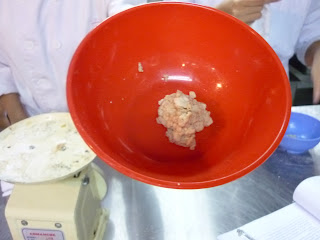The class on the 27th marked the first day of Food Innovation and Design (F.I.D) class operation with Chef
Zaid which will be held on every Thursday at 1.30 pm. It is mainly about teaching students on how to be innovative and creative in producing a new food item. The class is divided between Section 2 and Section 4 and was given a task in preparing a weekly report in the form of a blog.
We: Hanis, Fatin, Farah, Farahin and Najiha had agreed to form a team together. Unfortunately, two of the members: Farahin and Najiha couldn't make it on the 27th but the rest of the team were present to carry on with the class session.
Angel Cake was the appointed recipe to be accomplished for the day. The experiment will vary in terms of the number of strokes. The report will cover the whole process starting from the beginning till the end of activities. The activities started at
1.45 pm: Chef's Briefing
Description:
Chef Zaid started the class with a short briefing mainly on the Do s and Don't s within the class as well as the explanation on the production of the Angel Cakes.
2.30 pm: Preparing Mise en Place
Description:
The team started out with Mise en Place of the Angel Cake, accordingly:
Ingredients A
10g sugar
15g cake flour
Ingredients B
41g egg whites
32g sugar
0.1 salt
0.6 cream of tartar
And finally the whole mise en place was ready
2.45 pm: Initializing the Recipe
Description:
1. The whole process started with lining the case with wax paper.

2. Next, beating the egg whites until foamy followed by the addition of cream of tartar and salt, as well as gradually adding in the sugar.
 |
| Condition of egg white after adding cream of tartar and salt |
|
 |
| Egg whites turned silky smooth after the addition of sugar |
|
Moving on to the stage of folding in the cake flour, this was where the experimented subject will be executed. Step 2 is the controlled variable for the next two varied strokes. The first batter will be with
20 strokes:
 |
| After 20 strokes |
 |
| 20 strokes batter was placed into casing |
Then with
50 strokes (control):
 |
| After 50 strokes |
Finally, the
80 strokes:
 |
| After 80 strokes |
 |
| The 80 strokes which had a smoother batter compared to the other two |
4.17 pm: Starts baking
Description:
All three of the batter subjects were baked together at once with the temperature of 177 degree Celsius. Angel cakes are considered done when skewer comes out clean when inserted.
4.48 pm: Finished Baking
Description:
The whole baking process took
approximately 30 minutes.
 |
| Here is the "angel cake". The aftermath. From left: 80 strokes, 50 strokes and 20 strokes | | |
|
|
5.00 pm: Reviewing Session
Description:
All the appointed groups will present their experimented subjects based on the varied variables given. Chef Zaid had commented on each subjects. Each group was assigned to take note on each group's results.
 |
| Students taking note on every results |
The results of our Angel Cakes:
Treatment | Baking time | Volume (after baked) | Exterior | Texture of Crumb | Tenderness (# of chews) |
Colour | Shape |
1. Folding a. 20x |
30 minutes |
71g |
Brown |
Crack |
Hard |
10 |
b. 50x | 30 minutes | 71g | Dark Brown |
Crack |
Hard |
12 |
c. 80x | 30 minutes | 81g | Light Brown |
Crack |
Hard |
5 |
5.13 pm: Cleaning and Packing up
Description:
Kitchen was cleaned and belongings were packed.
5.45 pm: Class Dismissed
RECOMMENDATION
After gone through with the experiment, it is highly recommended to check on the angel cakes often to avoid the angel cakes being burnt.
CONCLUSION
Angel Cakes expands bigger when baked with lesser strokes which in this experiment, 20 strokes.





















































